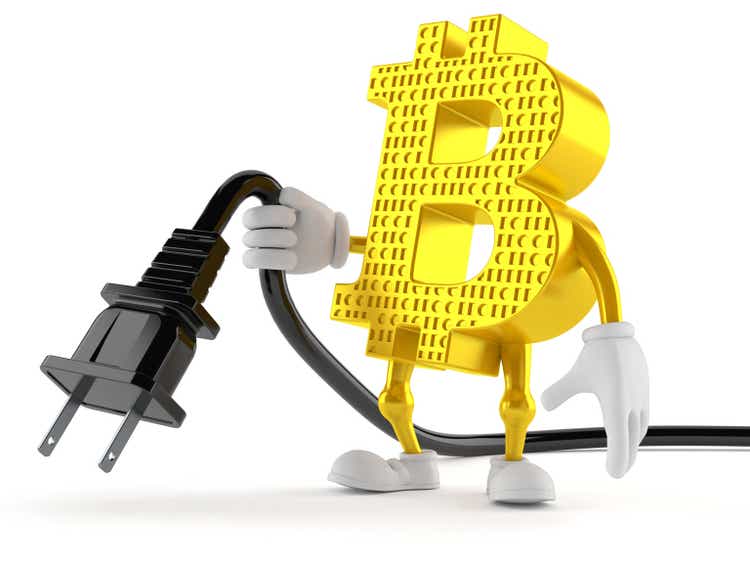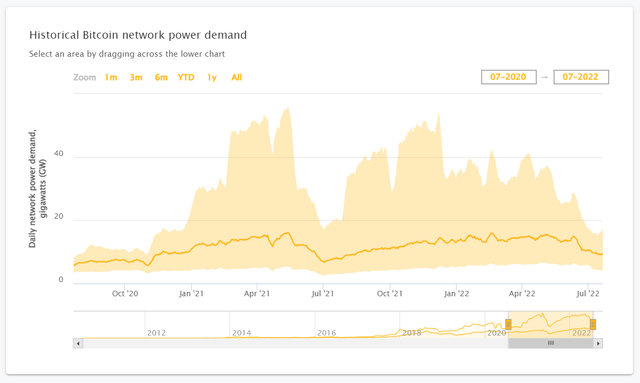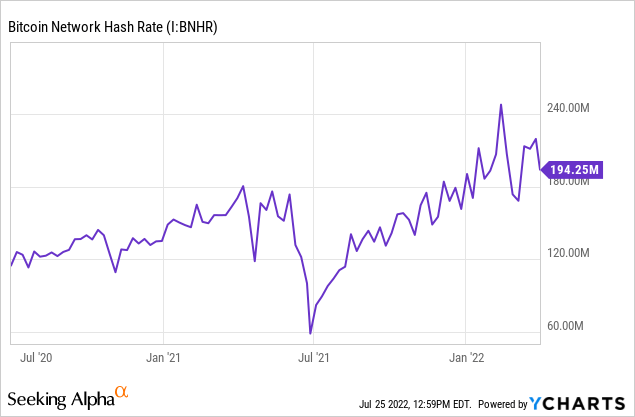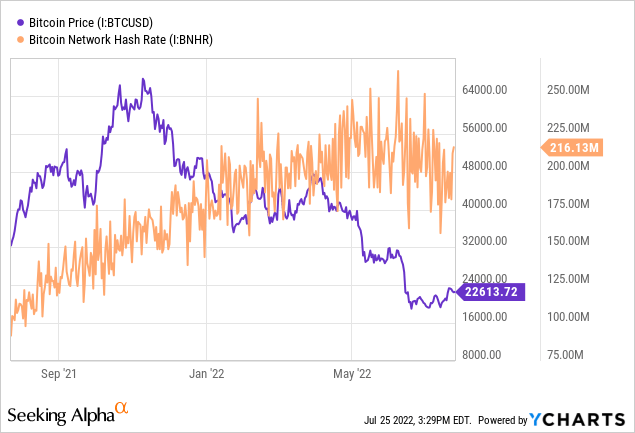Bitcoin: Are Crypto Miners Profitable at Today’s BTC Price?

Talaj/iStock via Getty Images
In a mid-July report, JPMorgan ( JPM ) estimated the cost of production for Bitcoin (BTC-USD) miners at around $13,000 per coin. This figure was widely reported in the crypto sector and business media. The general reporting seemed to overemphasizing the number itself and its implications for miners more generally. But, Decrypt run one interesting piece explored beyond the headline number and spoke with the CEO of mining company CleanSpark (CLSK) on the subject.
The JPMorgan report emphasized that the cost reduction could reduce the pressure on miners to sell their Bitcoin holdings. The report also attributed the lower production costs to a “strong effort” by miners to maintain profitability by using more efficient mining equipment. Related to this last idea, the report casts doubt on the assumption that a meaningful amount of lower-efficiency miners have gone offline.
The article below partly pushes back against these conclusions. It also presents a more detailed way of looking at mining costs, especially for the larger public mining companies based in the US and Canada. And it concludes with a look at the recent pivot in the overall network hash rate trend, a key component of yield and therefore cost per coin.
Cambridge Bitcoin’s Power Consumption Index
JPMorgan estimates that the average production cost per coin fell from around $20,000 in early June to today’s estimate of $13,000. In my opinion, this is a rather bold proposition. And importantly, they believe that the decline in costs was largely driven by the decline in electricity use.
The JPMorgan cost model uses the Cambridge Bitcoin Electricity Consumption Index as a proxy to measure electricity consumption. The graphic below shows CBECI’s best guess for daily power demand with its dark orange line. The shaded area represents the theoretical upper and lower limits of the daily demand. The lower bound basically represents all miners running the most efficient hardware, while the upper bound assumes all miners are using the least efficient hardware that is still profitable at the current Bitcoin price and total hash ratio.
Bitcoin Power Demand (CBECI)
Note the sharp decline in June this year, both in the best guess and the upper limit. In the CBECI method, with other factors held constant, when the price of Bitcoin falls, it will theoretically share of low-efficiency mining equipment is quickly removed from the calculation, as it is assumed to no longer be profitable. So during the June period, when prices collapsed and the overall network hash rate remained relatively flat, the model sees a large increase in productivity. Put another way, it weighs this equivalent hash rate to a theoretical set of significantly more efficient equipment, with lower power requirements. By extension, this means lower costs.
But CBECI knows that the model has limitations:
…miners are unlikely to be able to react as quickly to short-term changes in the profitability threshold. Although we attempt to smooth out the effects of short-term hashrate variations and price volatility, using a 14-day moving average (profitability threshold) may not be sufficient.
… assuming that all profitable equipment is equally distributed among miners is unrealistic given that not all hardware is produced in equal quantities and is readily available. The exact market share is unknown, although existing data suggests that a few large manufacturers dominate the market.
Source: MethodologyCambridge Bitcoin Electricity Consumption Index (link above)
Also note that CBECI fundamentally changed the model’s hardware selection method on May 17 of this year, reducing the representation of older equipment and eliminating all small-scale manufacturers’ rigs. They also happened to add three additional ultra-high-performance miners from Bitmain and MicroBT to the model’s hardware lineup in June.
For the above combined reasons, it is my opinion that the JPMorgan cost model is only loosely related to real dynamics, especially over a short 45-day time frame during a period of flux in a key component of the model’s methodology. To summarize, meaningful changes in the CBECI methodology in May and June, and the rapid drop in Bitcoin prices, caused a large, but only theoretical, decrease in the Bitcoin network’s energy usage. In turn, the JPMorgan cost model reports an unrealistic 35% reduction in Bitcoin mining costs per coin over just a month and a half.
Crypto Miners Now Selling Bitcoin Holdings
While some miners receive dollar-denominated income for providing hosting services, the income is mostly in the form of bitcoins. However, miners have significant energy, maintenance and administration costs in dollars. Recently, the miners have sold their Bitcoin production or part of their holdings to finance these current operations.
Over the past 18 months, it was more common for the miners to raise dollars through share sales, when share prices were high, or through financing, when they received preferred prices. So, in my opinion, a change in dollar-denominated costs will not meaningfully change the need to increase the sale of production or inventory as miners’ cash reserves decrease over time. For a period, even as stock prices recover, it is likely that miners will continue to sell output for dollars. Looking ahead, it is unlikely that all miners will return to a 100% hodl stance even if Bitcoin recaptures the $30,000 area.
Miner cost per coin
A useful way to look at current costs for miners is to pull data from 10-Q for US companies like Riot Blockchain (RIOT), and from MD&A for Canadian companies like Bitfarms (BITF). The adjusted selling cost per mined coin shown below represents energy costs plus items such as repairs, maintenance and upgrades to existing equipment and facilities. (Riot 10-Qs Link – Bitfarms MD&As Link)
Note that for simplicity, the discussion that follows does not include the meaningful general and administrative costs. As an example using Bitfarms, this type of cost, even excluding stock-based compensation, was a somewhat surprising $6,000 per coin in Q1’22. Depreciation costs have also been removed and, of course, no capital expenditure is included here.
Adjusted sales cost per mined coin
| Q3’21 | Q1’22 | |
| Riot Blockchain | $10,100 | $13,600 |
| Bit farms | $8600 | $10,600 |
Source: Author, from company reports
And over 80% of these adjusted selling costs per mined coin were energy costs.
Bitfarm’s direct costs per mined coin (energy costs)
| Q3’20 | Q4’20 | Q1’21 | Q2’21 | Q3’21 | Q4’21 | Q1’22 |
| 7.5000 dollars | 7.5000 dollars | $8.3K | $9.0K | $6.9K | $8.0K | $8.7K |
Source: Author, from company reports
Further direct costs on a per coin basis are most sensitive to the rapidly changing total hashrate of the network. Compare the timing and movements in the table above with the graphic below. And note that both the large increase in cost and overall network speed was due to the mining shutdown in China that temporarily reduced completions and increased returns for Western miners.

As JPMorgan noted, miners can marginally improve their cost per mined coin by adding new highly efficient miners every month. But keep in mind that these additions of thousands of units are generally added to large fleets of tens of thousands of rigs, the vast majority of which are also highly efficient. So changes in the overall network hashrate remain the driving and more meaningful force behind changes in miners’ costs on a per-coin basis.
Going Going forward: Total Network Hash rate
We have definitely seen a flattening and reversal in the overall network hashrate over the past two months. Note that the orange line in the graphic below shows the total hash rate and is in millions of TH/s. For reference, one million TH/s is one EH/s.

One factor driving a lower overall hash rate for the network is the record temperatures in the US and Europe. Riot meaningfully reduced power consumption in June, and most miners in Texas, for example, are said to have reduced significantly this month as well. This restriction is similar, but apparently more extensive, to that seen in the Canadian miners during the coldest winter months.
Bitcoin miners, increasingly using renewable sources, enable supply expansions that would not otherwise be economically feasible or feasible. During high demand, these sources can be used to mitigate brownouts. For those interested, Block (SQ) produced an interesting memo with data from ARK Invest titled, Bitcoin is the key to an abundant, clean energy future.
One additional item, the majority of Marathon Digital’s (MARA) Big 4 EH/s capable fleet went offline in June due to a storm at their main location in Hardin, MT. And note that the fleet mostly remains offline.
Finally, the war in Ukraine has been disruptive to energy markets. And because miners without energy contracts face higher prices in the current environment, and the price of Bitcoin has fallen significantly, there is likely some marginal loss in overall network hashrate at the low-efficiency end. For example, at Bitcoin prices below $24,000, the popular Bitmain S9 miners are likely unprofitable when paying over $0.04/KWh for power.
Energy prices may remain high for some time and partially reduce the overall hash rate growth in the network. But the limiting effects are likely to pass as autumn approaches. Marathon will eventually operate their fleet and already has plans to move equipment out of Montana. If Bitcoin prices were to regain the upper $20,000 range, low-efficiency miners will return. For these reasons, I expect to see a renewed trajectory towards a higher overall hash rate for the network as new equipment is always being deployed. And as mining becomes increasingly energy intensive at higher total rates, mining costs per coin will rise.
The bottom line for those investing in the Nasdaq-listed Bitcoin miners is not to overemphasize the JPMorgan report. Don’t chalk up the big reported increase in profitability to your second- and third-quarter earnings estimates.
The adjusted cost of sales per mined coin before SG&A expenses for these large miners is currently around $12,000. In Q2, these costs were likely flat to up as the overall network hash rate peaked in June. Going forward, I believe the upward trajectory of the overall network hash resumes and accelerates, pushing the cost per coin upwards of $1,000 per quarter. But even when factoring in SA&A expenses, prices above $20,000 represent low profitability.
Generally speaking, these miners are not financially stressed and can sell current production to cover current operations and service obligations. And these sales would not be large enough to affect pricing in the spot market. In current Bitcoin price and hashrate conditions, the major Western miners seem reasonable based on their current multiples, and they are considering holdings.
My new marketplace service is coming soon! Complete Crypto Analytics will launch in the near future and will have an in-depth, dedicated comparison feature for Bitcoin miners. Keep reading my articles here for updates so you can reserve your spot as a senior discount member! There will be a generous introductory price for early subscribers. Thank you for following my work.






















